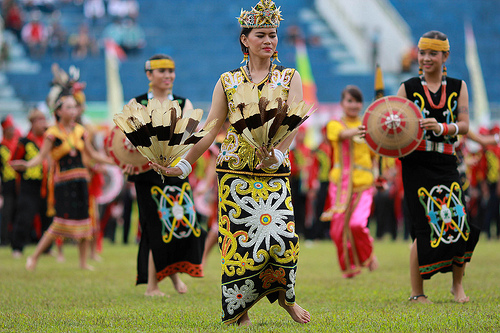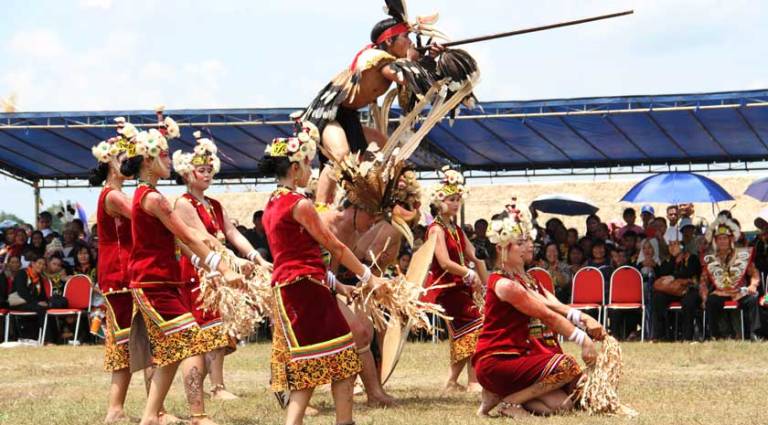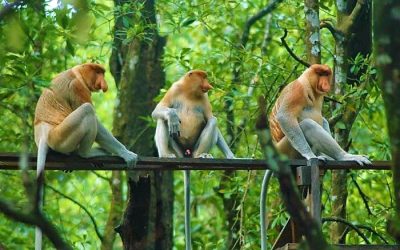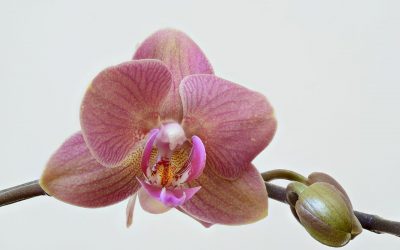Home / Batik Regions – Central Indonesia – Kalimantan Island – North Kalimantan / Malinau Cultural Festival
Cultural Destination
Embrace the spirit of the place!
Malinau Cultural Festival

Dayak Lundayeh Traditional Dance (photo: Indonesia.go.id)

The Kayan Traditional Dance (photo: Budaya Malinau)
Malinau Cultural Festival
You will witness unique competitions that would not be found in other than in Malinau District, for example, the hunting sword competition and the Dayak dance competition. You will also see the variety of textile heritage worn by different communities. This cultural festival is held once every two years for 13 days in October, prepare you holiday schedule to participate in this fantastic event!
Tourist Attractions in North Kalimantan
Tarakan Mangrove Forest
Mangrove Forest is one of the favourite tourism sites in Tarakan. We can go along the
Museum of Bulungan Sultanate
Bulungan is a historical museum to witness the legacy of the
Orchid Botanical Garden
Orchid Botanical Garden conserves various types of
North Kalimantan
Batik Motifs
Bultiya
The word ‘Bultiya’ is an acronym of the three major tribes in North Kalimantan, namely
Bekantan Pakis
This motif represents Pakis Haji (Polystichum setiferum), an endemic plant in
Dayak Taghol
Dayak Taghol has a distinctive style of four curved lines and small dots. This motif represents
Discover
Indonesian
Batik
Motifs
Tampuk Manggis Sasirangan
The motif illustrates the philosophy of the mangosteen fruit, which is
Pohon Hayat (Tree of Life)
The Batik motifs in Lampung are dominated by the acculturation of Buddhist and
Wirasat
Wirasat or divine inspiration is a gift from God. This inspiration is symbolized by
Rangkiang
The word “Rangkiang” refers to the rice granary in the Minangkabau language. It symbolizes
Bintik Tujuh
The Bintik Tujuh (Seven Dots) motif has 7 white spots and green color gradation as
Kasih Tak Sampai
‘Kasih Tak Sampai’ is an idiom in the Indonesian language which refers to
Kawung
The Kawung motif was created by Sultan Agung Hanyokrokusumo (1593 – 1645) as a symbolic gift for
Pinawetengan
The Pinawetengan Batik pattern was taken from a prehistoric inscription in
Pala Salawaku
This motif illustrates the unique weapons of the Maluku region, namely
Besurek Rafflesia
The term “Basurek” refers to a textile that contains letters or inscriptions
Gonggong Siput
Gonggong (Strombus Turturella) is one type of sea snail found around
Angsa Duo
According to legend, the Angso duo batik motif is a pair of swans that are believed to have led Princess
Enggang Dayak
Local people beliefs that hornbills are an incarnation of the Commander of the Birds. It has supernatural
Tenun Bima
The motifs are adopted from Bima woven textile. This pattern has received a great
Ukir Sentani
The Ukir motif is a batik motif that is inspired by various traditional Sentani wood carvings
Lontara
The Lontara script itself is a typical ancient script of Bugis and Makassar communities. History records that
Ikan tambal
The word “Ikan” refers to fish. The philosophical meaning of Ikan Tambal means is
Burung Bidadari
Bidadari birds are endemic birds in Halmahera. This motif represents an
Bomba Mawar
This motif means sacred love for family, kingdom, and God; It also illustrates
Sekomandi
Its philosophical meaning is the eternal union which refers to a saying “until death do us part”
Tifa Totobuang
The batik motifs illustrate Maluku’s traditional music instrument called
Tubo Kelapa
Coconut tree is a symbol of a good character and strong mentality. It illustrates the more success a person, the more
Kaganga Tanah Rejang
If Batik Besurek combines Arabic calligraphy motifs, then the Kaganga batik takes
Dayak Taghol
Dayak Taghol has a distinctive style of four curved lines and small dots. This motif represents
Desa Na Tolu
The Desa Na Tolu characteristic pattern symbolizes the Batak philosophy of existence and
Gentala Arasy
Built as high as 80 meters, the tower also highlights the historical side of
Biji Kopi
The coffee seeds motif illustrates the pride of local coffee specialities in
Daun Lada Hitam
The black pepper motif represents the main commodity of Bangka Belitung
Gonggong Beruntun
This motif illustrates that a person should maintain a positive attitude and
Gedhog Kembang Waluh
a combination of Javanese cultural motif of the Majapahit kingdom (XII-XIV century) with
Pati-Pati Pinehiku
It symbolizes the hierarchy in society and the social status of the Mekongga
Honai
The Honai is inspired by the traditional house of the Papuan community living in
Kain Cual
Cual textile tradition has existed since the 17th century. The word “Cual” refers to
Salakanagara
Salakanagara batik motif illustrates the first kingdom in the Betawi land
Gurdo Solo
Gurdo or garuda bird is the mount of the Indian god Vishnu. As the Sun Bird,
Tongkonan
Toraja’s traditional house is called Tongkonan. Tongkonan is a place for
Pucuk Rebung Riau
Pucuk Rebung symbolizes heart determination in achieving goals, good luck, and
Parang Seling
Parang Seling or “alternating daggers” is a royal batik motif. It is a feminine variant of
Tengkawang Ampiek
With its many advantages, the Dayaks use this leaf in ritual ceremonies. This plant is a symbol of
Taiganja
Taiganja is a precious gold pendant that shows the social status of the Kaili family. It is
Parang Rusak
Another meaning behind this motif is an unconquerable spirit, symbolized by
Rumah Mamuju
the Batik motif illustrates the house of Mamuju King with the stairs, located on the left of the wooden stage house
Gigi Haruan Lidi
The Gigi Haruan Lidi motif is taken from the name of the cork fish and is a symbol of
Daun Simpor
This motif is inspired by the Simpor plant (Dillenia Suffruticosa) which is a typical
Keluak Daun Pakis
The word “Keluak” is a Minang language which means twisted or tangled. The Motif of
Jupri Kembang Teh
Kembang Teh illustrates the tendrils of tea plants that grow in the highlands of
La Galigo
La Galigo is a literary work of the Buginese Epic that has 300 thousand epic lines. It is considered even
Insang Ikan
Insang refers to the gills of the fish. This is a typical pattern of Malay ethnic who inhabits
Sekar Jati
Sekar means flower and Jati refers to teak trees that symbolizes a strong mental character that
Prada Papua
The word “Prada” in the Javanese-Indonesian dialect means a batik textile that
Lok Baintan Floating Market
As you can imagine, the most authentic thing is that you can buy things and even
Daun Sirih
This motif illustrates betel leaves that are used by Lombok communities as traditional
Teguh Bersatu
This batik motif shows the strength of the people of Kupang. It also represents a sense of
Mahkota Siger
Siger is the crown of a noblewoman in ancient time. It is a symbol of femininity, strength, and
Tanah Liek
The word “Tanah Liek” refers to clay in Minang language. It is also known as
Sandeq
Sandeq Boat is a symbol of the maritime importance of the West Sulawesi region. The greatness of
Jumputan Bintang
The word Jumputan means the tie-dye technique, while the word “Bintang” refers to
Cengkeh
The clove flower motif is the main commodity of the Tolitoli Regency. This motif represents
Srimanganti
The name of the Srimanganti motif is derived from Palace’s hallway that connects to
Merak Ngeram
The hatching peacock motif has a very deep meaning which refers to the sacrifice and
Bultiya
The word ‘Bultiya’ is an acronym of the three major tribes in North Kalimantan, namely
Kaharingan
The Kaharingan or ‘tree of life’ based on the Dayak tribes’ belief system. This tree symbolizes
Awan Berarak
Awan Berarak is a combination of Dayak motifs and Malay patterns. The word ‘Awan Berarak’ means the
Sero Tangga
The Sero Tangga illustrates an endearing feeling and sacrifices of a person to fulfil
Karawo Pinang
Pinang refers to the Palm areca tree. This motif is considered as the original
Wakatobi
It symbolizes the coastal beauty of the Wakatobi island and the symbol of Patra symbolizes
Tangerang Herang
Tangerang Herang motif is a symbol of Tangerang city. The Tangerang Herang batik motif consists of
Tabir Tanjung
Tanjung flower is a type of Cherry tree flower, which is commonly found in
Gajah Way Kambas
The motif illustrates the Lampung’s natural reserve, the Way Kambas. it also symbolizes
Durian Pecah
Broken Durian motifs depict the foundation of faith. The second half signifies the mastery of
Manguni Minahasa
Manguni is identified as the symbol of the Minahasa people. Manguni is known as a
Gumin Tambun
Based on Hindu mythology, this motif symbolizes lucks, abundant wealth, and
Besurek Rembulan
This batik illustrates praise for God who created the wonderful universe
Gorga Simeol-Meol
The Gorga Simeol-meol is a pattern of plant tendrils. it is regarded as a symbol of longevity and



